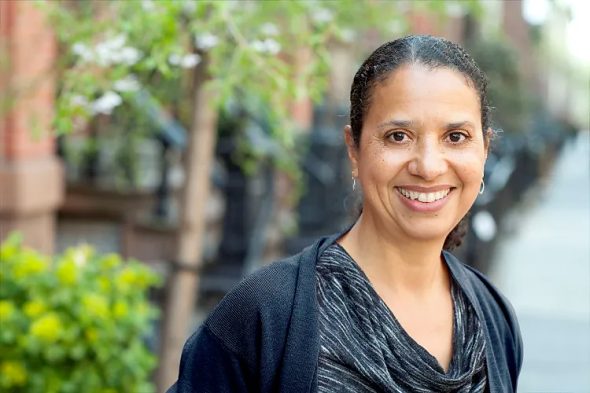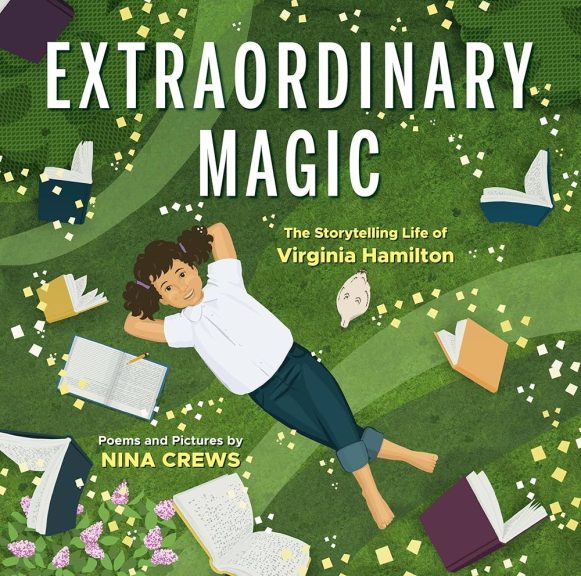
“Extraordinary Magic: The Storytelling Life of Virginia Hamilton,” a children’s picture and poetry book by Nina Crews was published by Christy Ottaviano Books in January of this year. The publication celebrates the life of Yellow Springs-based writer, the late Virginia Hamilton. (Submitted photo)
Brooklyn author explores Virginia Hamilton’s magic
- Published: September 1, 2024
On opening the newly published children’s biography, “Extraordinary Magic: The Storytelling Life of Virginia Hamilton,” the reader will come to a page holding the image of a young girl reading a book.
She sits cross legged on a magic carpet, floating in the air. Below is a quote by the famed author from Yellow Springs, Virginia Hamilton: “By the age of four or five, we have experienced everything we need to write fiction …”
This depiction of Hamilton as a young girl engaged in reading — an activity that is so inextricably linked to her life’s calling — is how Brooklyn-based author and illustrator Nina Crews begins her story of Hamilton’s life. In her lyrical picture book biography, Crews utilizes poetry to tell the story of Hamilton’s life.
The poems, entirely written by Crews, are inspired by anecdotes Hamilton shared through speeches, essays and interviews made over her lifetime — some of which Crews collected in the Antioch College archives.
Hamilton, raised in the village, was the first African American to win a Newbery Medal, which honors the contributions of writers of children’s literature.
She created intricate and complicated worlds of Black children and teens in her books, trailblazing the way for other authors interested in telling the story of children from different cultures in the U.S.
Before her death in 2002, the award-winning author had published 41 books. She wrote across multiple genres including picture books, folktales, mysteries, science fiction, realistic novels and biographies.
Crews’ “Extraordinary Magic” speaks to Hamilton’s lineage — first telling the story of Hamilton’s great grandmother who escaped enslavement, before introducing the reader to young Virginia.
Hamilton’s imagination was cultivated through her parents, Kenneth James Hamilton, whose name villagers may recognize from the street named after him, and mother, Etta Belle Perry Hamilton. In this stanza of the poem “Mother,” a very young, frightened Virginia is comforted during a scary storm:
“Don’t worry Ginny,” said Mother.
“See how Grandmother Lilac bows down.
And the trees bend with her.
Here comes the wind! Whee!”
The poetry is further empowered by Crews’ illustrations, digital collages of bold imagery, not just depicting Hamilton, but her family, friends and physical surroundings — particularly nature — all of it conveying Hamilton’s life through visual narrative. Readers can enter into Hamilton’s free-spirited childhood, anchored by her monumental decision to become a writer at age nine. Crews also writes and illustrates Hamilton’s journey to New York City to begin her professional career as a writer, meeting her husband, Arnold Adoff, and their return to Yellow Springs to raise two children on Hamilton-family-owned land.
Along with “Extraordinary Magic,” Crews has written and illustrated a number of children’s books, providing illustrations for “Not Done Yet: Shirley Chisholm’s Fight for Change,” by Tameka Fryer Brown; and “Seeing into Tomorrow: Haiku by Richard Wright,” a book that celebrates young Black boys.
One reason Crews, an award-winning author in her own right, wanted to write a children’s book about Virginia Hamilton is her own lineage, which is steeped in storytelling.
“I don’t know if you also are aware that my parents were children’s book authors and illustrators,” Crews said in a recent interview with the News. “So, coming around to [children’s books] kind of was a circle that made a lot of sense for me, for a lot of reasons. Virginia Hamilton kind of came about through a few different things.”
Before creating children’s books, Crews, who also has a background in animation, got her start working on the 1980s children’s series, “Pee-wee’s Playhouse.”
“And then I moved into more boring things,” she said. “I was working with a lot of other artists, and we were all kind of finding our way through to ways to put those creative energies to use in different forms and different vessels, as it were.”
It’s one thing to create children’s books from the imagination, but writing biographies for children requires a different approach. The idea to write one came as a suggestion over a lunch meeting with her editor, Christie Aviano, after they’d worked on a number of projects together.
“At that point, I really hadn’t thought about it, because I had this little space that I was working in that was fictional picture books told with these photographs and stuff. But, you know, time goes on and I start thinking, [writing biographies] in the back of my head. One of the books I did next was, ‘Seeing Into Tomorrow,’ which was Richard Wright’s Haiku book, and for that book, I did a little bit of biography at the back of it,” Crews said.
According to Crews, Virginia Hamilton came about “because I also just wanted to think about work that brought forth a Black woman. That was really important to me as I was thinking about ideas, about people.”
After doing some research on Hamilton’s background, Crews concluded there was enough information to make a book about her life.

“Extraordinary Magic: The Storytelling Life of Virginia Hamilton,” a children’s picture and poetry book by Nina Crews was published by Christy Ottaviano Books in January of this year. The publication celebrates the life of Yellow Springs-based writer, the late Virginia Hamilton. (Submitted photo)
“Once I started reading her speeches and her essays, and how she talked about herself, I saw her bringing her childhood experience into these speeches. So, I thought, ‘Oh, there’s a lot of material here that’s going to be relatable, tangible for kids,’” Crews said.
Crews was also motivated to bring Hamilton’s work to a new generation of children.
“I wanted people to read her books, and I don’t think that they are read as much anymore. And reading through them, I recognize, you know, the style of middle grade [young adult literature] books has changed a bit,” Crews said.
It can take some patience, Crews added, to read some of Hamilton’s work, given the changes in current young adult literature, but that did not deter her from writing the biography.
“I thought, well, let’s just put it out there and maybe that’ll encourage that kid who really is a reader, who might be willing to just sit there and dig in a little bit more with ‘MC Higgins The Great’ that another kid might say, ‘I cannot,’” she said.
Crews found a number of sources helpful in her research, including archives from the YS News related to the arrival of Hamilton’s family to the area in the 1800s.
“She often mentions her grandfather and that story of her grandfather being brought from Virginia to Ohio. … All of a sudden, I’m sitting and I’m reading through information … abolitionist history in Ohio and the Yellow Springs News was great,” Crews said.
Crews also found an out-of-print copy of a book of Hamilton’s speeches that her husband, Arnold Adoff, anthologized, called “Speeches, Essays and Conversations.”
“That was really the main, starting place to work out from everything else. So, reading through her talking about her childhood, I started just writing notes and thinking about, first, how to create it as a continuous prose,” Crews said.
She also met with Adoff before he died in 2021, describing it as a “beautiful, wonderful, thing.” According to Crews, when Adoff found out about the book, “he was delighted.”
“He is like, let’s talk and, you know, record me, take your time. We talked for quite a while and it was early in COVID, so that was also a subject. That was really nice,” Crews said.
Crews also said that Adoff knew her parents because of their professional affiliation.
“He’d met my dad, and I think my dad had met both [Hamilton and Adoff]. I think my mom might have just met Arnold. But they kind of all knew each other because they were contemporaries in the field and we were Facebook friends,” Crews said.
Another important source of research for Crews was the local nonprofit, The 365 Project, whose mission is to promote African American heritage in the community.
“I’ve read through all of their things that I could find online,” Crews said.
Crews also visited Yellow Springs, after the project was green-lit, exploring the natural elements that Hamilton was inspired by, including spending time in Glen Helen Nature Preserve.
“Having the sense of the natural space, and of a connection to even the cosmic to a certain degree, was very intentional, because that is one of the things that I took from her writing,” Crews said. “What was clear to me was that Yellow Springs was hugely important to her — as a place and a sort of grounding element in her life.”
The Yellow Springs News encourages respectful discussion of this article.
You must login to post a comment.
Don't have a login? Register for a free YSNews.com account.















No comments yet for this article.